英文药品说明书
- 格式:pptx
- 大小:180.29 KB
- 文档页数:1
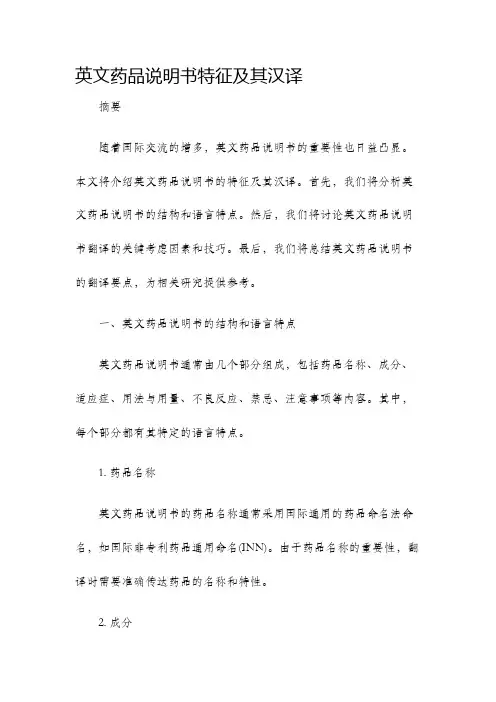
英文药品说明书特征及其汉译摘要随着国际交流的增多,英文药品说明书的重要性也日益凸显。
本文将介绍英文药品说明书的特征及其汉译。
首先,我们将分析英文药品说明书的结构和语言特点。
然后,我们将讨论英文药品说明书翻译的关键考虑因素和技巧。
最后,我们将总结英文药品说明书的翻译要点,为相关研究提供参考。
一、英文药品说明书的结构和语言特点英文药品说明书通常由几个部分组成,包括药品名称、成分、适应症、用法与用量、不良反应、禁忌、注意事项等内容。
其中,每个部分都有其特定的语言特点。
1. 药品名称英文药品说明书的药品名称通常采用国际通用的药品命名法命名,如国际非专利药品通用命名(INN)。
由于药品名称的重要性,翻译时需要准确传达药品的名称和特性。
2. 成分英文药品说明书通常列出药品的成分和含量。
这部分的翻译需要注意准确传达成分的名称和浓度。
3. 适应症英文药品说明书会描述药品适用于治疗的疾病或症状,翻译时需要确保准确传达治疗的目标。
4. 用法与用量英文药品说明书会详细描述药品的用法和用量,包括剂型、给药途径、频率等。
翻译时需要准确传达这些信息,以确保患者正确使用药品。
5. 不良反应英文药品说明书会列出可能的不良反应和副作用。
翻译时需要准确传达这些信息,帮助患者和医生了解和应对可能的风险。
6. 禁忌和注意事项英文药品说明书会列出药品的禁忌和使用时需要注意的事项。
翻译时需要准确传达这些信息,以确保患者正确使用药品并避免潜在的风险。
二、英文药品说明书翻译的关键考虑因素和技巧翻译英文药品说明书需要考虑以下因素和运用相关技巧。
1. 专业知识翻译人员需要具备一定的药学和医学知识,以便准确理解和翻译药品说明书。
2. 术语翻译准确性和一致性药品说明书中有许多专业术语,翻译时需要准确传达其意义,并确保翻译的一致性,避免术语混乱。
3. 文风与目标受众药品说明书的语言通常较为正式和严谨,翻译时需要适应目标受众的阅读习惯和语言风格。
4. 法律法规和文化差异不同国家对药品说明书的要求和规定不同,翻译时需要遵守相应法律法规,并注意文化差异。

药品英文说明书药品英文说明书药品英文说明书药品英文说明书篇一:药品说明书英文翻译英语药品说明书的翻译英语药品说明书由以下12项内容组成,大多数英语药品说明书结构基本相同。
1. pakage insert (insert)说明书2. drug name (medicine) 药品名称3. description 性状4.action 作用 5. indication适应症6. contraindications 禁忌症 7. precaution注意事项 8. side effects副作用 9. dosage and administration 剂量和用法 10. dacking 包装 11.expiry 失效期 12. manufactring date (manu.date)出厂日期 13.reference 参考文献药品名称一、英语药品说明书一般用商品名,由生产厂家向该国政府有关部门申请注册正式名称,受该国政府法律保护,在药品名称的右上角有个?r的符号,意思是已经申请注册的法定名称,不可随意改变名称。
?r=recive 在药品之后有时issued to(for) the medical profession only短语,意:仅供医界参考。
r例:mobic ? issued to(for) the medical prfession.二、译法:分四种译法1. 音译:按英语读音用相应的汉字译出例:mobic莫比可 rifampicin利福平 2. 意译:按药品名称各组成部份的英语意义译成汉语例:streptomycine是由strepto和mycine组成,其中strepto(链球状),mycine(霉素),则按英语意思,译成:链霉素。
因此必须掌握大量前、后缀,才以准确翻译,此种译法多数是抗生素类药物。
nitroglycerine 由nitro(硝基)+glycerin(甘油)组成,则意为硝酸甘油aminophylline由amino+phylline译:氨茶碱 3. 音意并译:按英语药名组成,前面部份按音译,后面部份按意译。
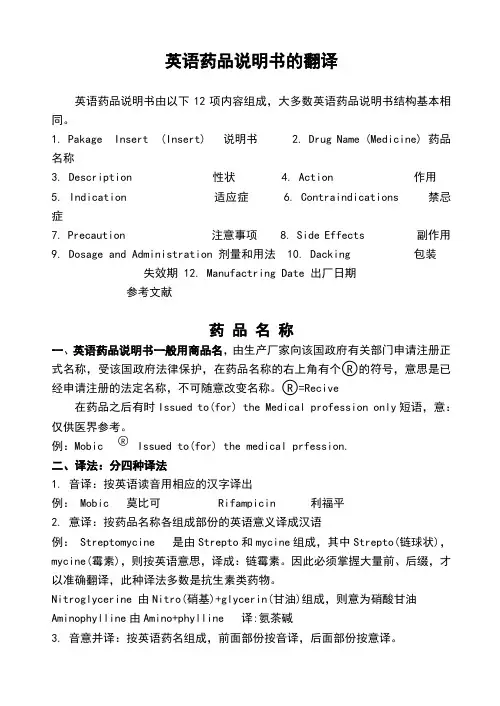
英语药品说明书的翻译英语药品说明书由以下12项内容组成,大多数英语药品说明书结构基本相同。
1. Pakage Insert (Insert) 说明书2. Drug Name (Medicine) 药品名称3. Description 性状4. Action 作用5. Indication 适应症6. Contraindications 禁忌症7. Precaution 注意事项 8. Side Effects 副作用9. Dosage and Administration 剂量和用法 10. Dacking 包装失效期 12. Manufactring Date 出厂日期参考文献药品名称一、英语药品说明书一般用商品名,由生产厂家向该国政府有关部门申请注册正式名称,受该国政府法律保护,在药品名称的右上角有个○R的符号,意思是已经申请注册的法定名称,不可随意改变名称。
○R=Recive 在药品之后有时Issued to(for) the Medical profession only短语,意:仅供医界参考。
例:Mobic ○R Issued to(for) the medical prfession.二、译法:分四种译法1. 音译:按英语读音用相应的汉字译出例: Mobic 莫比可 Rifampicin 利福平2. 意译:按药品名称各组成部份的英语意义译成汉语例: Streptomycine 是由Strepto和mycine组成,其中Strepto(链球状),mycine(霉素),则按英语意思,译成:链霉素。
因此必须掌握大量前、后缀,才以准确翻译,此种译法多数是抗生素类药物。
Nitroglycerine 由Nitro(硝基)+glycerin(甘油)组成,则意为硝酸甘油Aminophylline由Amino+phylline 译:氨茶碱3. 音意并译:按英语药名组成,前面部份按音译,后面部份按意译。

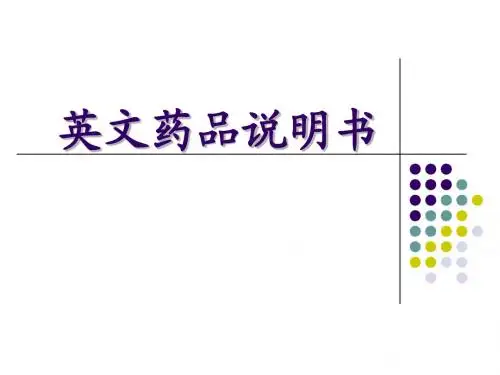
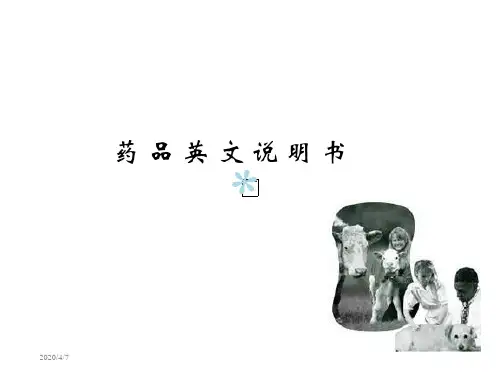
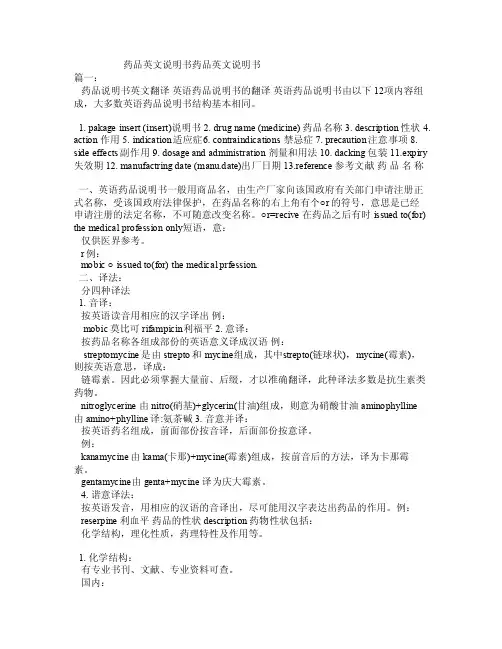
药品英文说明书药品英文说明书篇一:药品说明书英文翻译英语药品说明书的翻译英语药品说明书由以下12项内容组成,大多数英语药品说明书结构基本相同。
1. pa kageinser t (in sert)说明书2. drug name (med icine) 药品名称 3.descr iptio n 性状4. ac tion作用 5. indi catio n适应症6. con train dicat ions禁忌症7. pre cauti on注意事项 8.sideeffec ts副作用 9. d osage andadmin istra tion剂量和用法 10.dacki ng 包装 11.e xpiry 失效期12. m anufa ctrin g dat e (ma nu.da te)出厂日期 13.refe rence参考文献药品名称一、英语药品说明书一般用商品名,由生产厂家向该国政府有关部门申请注册正式名称,受该国政府法律保护,在药品名称的右上角有个○r的符号,意思是已经申请注册的法定名称,不可随意改变名称。
○r=re cive在药品之后有时iss ued t o(for) the medi cal p rofes siononly短语,意:仅供医界参考。
r例: mob ic ○issue d to(for)the m edica l prf essio n.二、译法:分四种译法1. 音译:按英语读音用相应的汉字译出例:mobic莫比可r ifamp icin利福平 2.意译:按药品名称各组成部份的英语意义译成汉语例:strep tomyc ine是由strep to和my cine组成,其中s trept o(链球状),myc ine(霉素),则按英语意思,译成:链霉素。
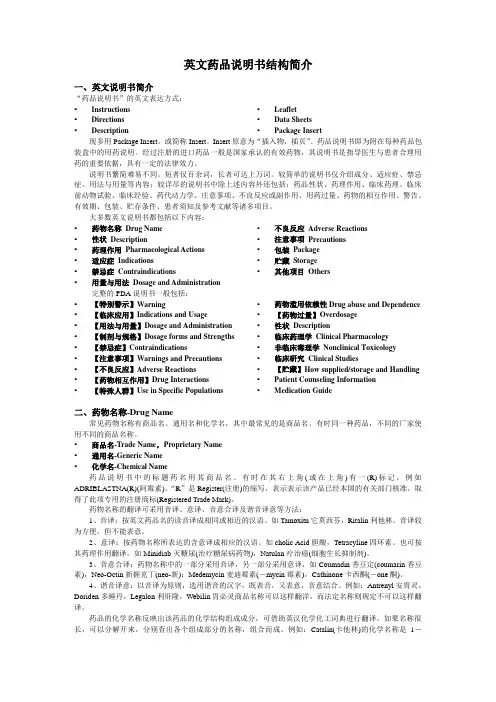
英文药品说明书结构简介一、英文说明书简介“药品说明书”的英文表达方式:•Instructions •Directions •Description •Leaflet •Data Sheets •Package Insert现多用Package Insert,或简称Insert。
Insert原意为“插入物,插页”。
药品说明书即为附在每种药品包装盒中的用药说明。
经过注册的进口药品一般是国家承认的有效药物,其说明书是指导医生与患者合理用药的重要依据,具有一定的法律效力。
说明书繁简难易不同。
短者仅百余词,长者可达上万词。
较简单的说明书仅介绍成分、适应症、禁忌症、用法与用量等内容;较详尽的说明书中除上述内容外还包括:药品性状、药理作用、临床药理、临床前动物试验、临床经验、药代动力学、庄意事项、不良反应或副作用、用药过量、药物的相互作用、警告、有效期、包装、贮存条件、患者须知及参考文献等诸多项目。
大多数英文说明书都包括以下内容:•药物名称Drug Name•性状Description•药理作用Pharmacological Actions •适应症Indications•禁忌症Contraindications•用量与用法Dosage and Administration •不良反应Adverse Reactions •注意事项Precautions•包装Package•贮藏Storage•其他项目Others完整的FDA说明书一般包括:•【特别警示】Warning•【临床应用】Indications and Usage•【用法与用量】Dosage and Administration •【制剂与规格】Dosage forms and Strengths •【禁忌症】Contraindications•【注意事项】Warnings and Precautions •【不良反应】Adverse Reactions•【药物相互作用】Drug Interactions •【特殊人群】Use in Specific Populations •药物滥用依赖性Drug abuse and Dependence •【药物过量】Overdosage•性状Description•临床药理学Clinical Pharmacology•非临床毒理学Nonclinical Toxicology•临床研究Clinical Studies•【贮藏】How supplied/storage and Handling •Patient Counseling Information •Medication Guide二、药物名称-Drug Name常见药物名称有商品名、通用名和化学名,其中最常见的是商品名。
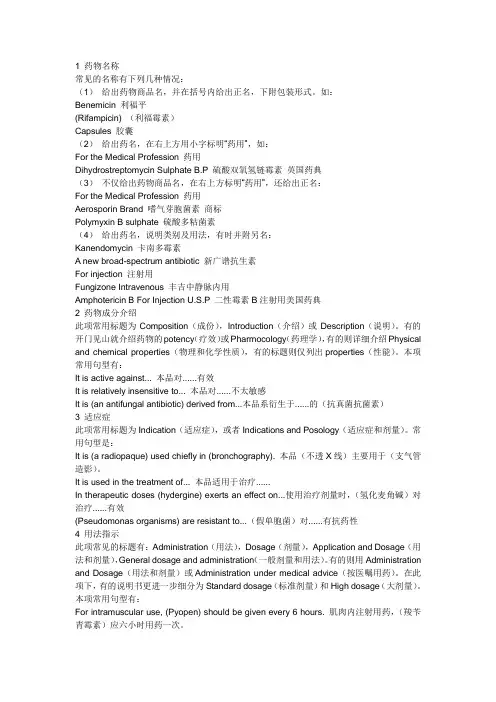
1 药物名称常见的名称有下列几种情况:(1)给出药物商品名,并在括号内给出正名,下附包装形式。
如:Benemicin 利福平(Rifampicin) (利福霉素)Capsules 胶囊(2)给出药名,在右上方用小字标明“药用”,如:For the Medical Profession 药用Dihydrostreptomycin Sulphate B.P 硫酸双氧氢链霉素英国药典(3)不仅给出药物商品名,在右上方标明“药用”,还给出正名:For the Medical Profession 药用Aerosporin Brand 嗜气芽胞菌素商标Polymyxin B sulphate 硫酸多粘菌素(4)给出药名,说明类别及用法,有时并附另名:Kanendomycin 卡南多霉素A new broad-spectrum antibiotic 新广谱抗生素For injection 注射用Fungizone Intravenous 丰吉中静脉内用Amphotericin B For Injection U.S.P 二性霉素B注射用美国药典2 药物成分介绍此项常用标题为Composition(成份),Introduction(介绍)或Description(说明)。
有的开门见山就介绍药物的potency(疗效)或Pharmocology(药理学),有的则详细介绍Physical and chemical properties(物理和化学性质),有的标题则仅列出properties(性能)。
本项常用句型有:It is active against... 本品对......有效It is relatively insensitive to... 本品对......不太敏感It is (an antifungal antibiotic) derived from...本品系衍生于......的(抗真菌抗菌素)3 适应症此项常用标题为Indication(适应症),或者Indications and Posology(适应症和剂量)。
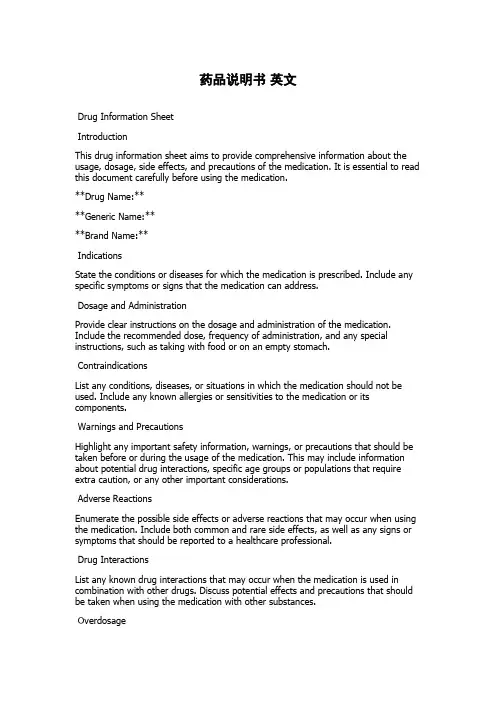
药品说明书英文Drug Information SheetIntroductionThis drug information sheet aims to provide comprehensive information about the usage, dosage, side effects, and precautions of the medication. It is essential to read this document carefully before using the medication.**Drug Name:****Generic Name:****Brand Name:**IndicationsState the conditions or diseases for which the medication is prescribed. Include any specific symptoms or signs that the medication can address.Dosage and AdministrationProvide clear instructions on the dosage and administration of the medication. Include the recommended dose, frequency of administration, and any special instructions, such as taking with food or on an empty stomach.ContraindicationsList any conditions, diseases, or situations in which the medication should not be used. Include any known allergies or sensitivities to the medication or its components.Warnings and PrecautionsHighlight any important safety information, warnings, or precautions that should be taken before or during the usage of the medication. This may include information about potential drug interactions, specific age groups or populations that require extra caution, or any other important considerations.Adverse ReactionsEnumerate the possible side effects or adverse reactions that may occur when using the medication. Include both common and rare side effects, as well as any signs or symptoms that should be reported to a healthcare professional.Drug InteractionsList any known drug interactions that may occur when the medication is used in combination with other drugs. Discuss potential effects and precautions that should be taken when using the medication with other substances.OverdosageProvide information on the signs and symptoms of overdose, as well as the recommended actions to be taken in case of an overdose. Include contact information for emergency medical assistance.Storage and HandlingHighlight any specific storage requirements for the medication, such as temperature conditions, protection from light, or any other relevant information. Also, include instructions on the proper handling and disposal of unused medication.ReferencesInclude any references or sources that were consulted when creating this drug information sheet. This may include authoritative drug databases, clinical studies, or other relevant sources.ConclusionIt is essential to follow the instructions and precautions mentioned in this drug information sheet. If there are any questions or concerns about the medication, don't hesitate to consult a healthcare professional.。
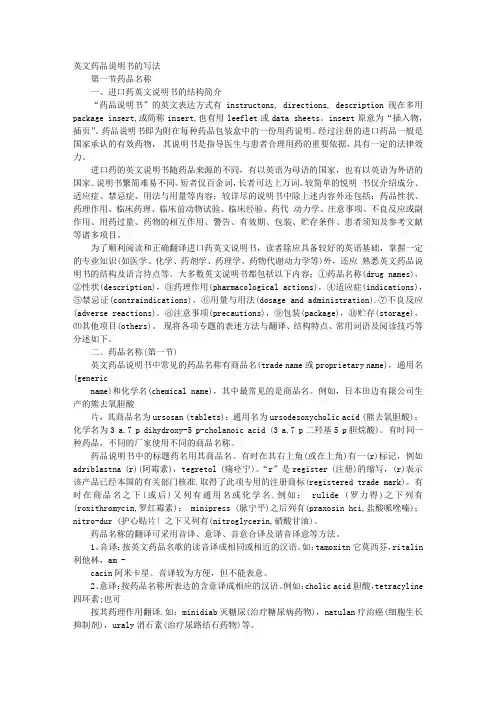
英文药品说明书的写法第一节药品名称一、进口药英文说明书的结构简介“药品说明书”的英文表达方式有instructons, directions, description现在多用package insert,或简称insert,也有用leeflet或data sheets。
insert原意为“插入物,插页”。
药品说明书即为附在每种药品包装盒中的一份用药说明。
经过注册的进口药品一般是国家承认的有效药物,其说明书是指导医生与患者合理用药的重要依据,具有一定的法律效力。
进口药的英文说明书随药品来源的不同,有以英语为母语的国家,也有以英语为外语的国家。
说明书繁简难易不同。
短者仅百余词,长者可达上万词。
较简单的悦明书仅介绍成分、适应症、禁忌症、用法与用量等内容;较详尽的说明书中除上述内容外还包括:药品性状、药理作用、临床药理、临床前动物试验、临床经验、药代动力学、庄意事项、不良反应或副作用、用药过量、药物的相互作用、警告、有效期、包装、贮存条件、患者须知及参考文献等诸多项目。
为了顺利阅读和正确翻译进口药英文说明书,读者除应具备较好的英语基础,掌握一定的专业知识(如医学、化学、药剂学、药理学、药物代谢动力学等)外,还应熟悉英文药品说明书的结构及语言待点等。
大多数英文说明书都包括以下内容;①药品名称(drug names),②性状(description),③药理作用(pharmacological actions),④适应症(indications),⑤禁忌证(contraindications),⑥用量与用法(dosage and administration).⑦不良反应(adverse reactions)。
⑧注意事项(precautions),⑨包装(package),⑩贮存(storage),⑾其他项目(others)。
现将各项专题的表述方法与翻译、结构特点、常用词语及阅读技巧等分述如下。
二、药品名称(第一节)英文药品说明书中常见的药品名称有商品名(trade name或proprietary name),通用名(genericname)和化学名(chemical name),其中最常见的是商品名。
英文药品说明书范文Drug Name: Acitretin CapsulesDescription: Acitretin is a retinoid, related to vitamin A. It is used to treat severe psoriasis, and other skin conditions, as well as nail dystrophies.Indications: Acitretin capsules are indicated for the treatment of severe psoriasis and other skin conditions. It is also used to treat nail dystrophies.Dosage and Administration: The dosage of Acitretin should be individualized. The usual starting dose is 10 to 25 mg oncedaily on an empty stomach. The dose may be increased or reduced depending on the response. The maximum daily dose should not exceed 50 mg.Contraindications: Acitretin is contraindicated in patients with a history of porphyria, sensitivity to any retinoid, hepatic failure, or a history of alcohol abuse.Warnings and Precautions: Acitretin should be used with caution in patients with liver or kidney disease. It should also be used with caution in pregnant women and nursing mothers. Women of childbearing potential should use adequate contraception during treatment and for three years after stopping treatment.Overdose: In case of an overdose, immediately seek medical attention.Storage: Acitretin should be stored at room temperature, away from heat and direct light.Conclusion: Acitretin is an effective and well-tolerated treatment for severe psoriasis, other skin conditions, and nail dystrophies. Patients should closely follow their doctor’s instructions for receiving the best results from the treatment.。
药品说明书英文Drug Instructions (English)IntroductionThe drug instructions provide important information about the medication, its usage, dosage, and potential side effects. It is important to read and understand the instructions carefully before taking the medication. This document aims to provide a detailed description of the medication and its usage in English.Drug Name- **Generic Name**: [Generic Name]- **Brand Name**: [Brand Name]DescriptionThe medication, available in the form of [tablet/capsule/liquid/injection], is prescribed for the treatment of [specific condition or disease]. It contains [active ingredient] as the main component. The medication works by [mechanism of action]. It is important to strictly follow the instructions provided to ensure safe and effective use of the medication.IndicationsThe medication is indicated for the treatment of the following conditions:- [Indication 1]- [Indication 2]- [Indication 3]Dosage and AdministrationDosageThe dosage of the medication may vary depending on factors such as the patient's age, weight, and severity of the condition being treated. It is important to follow the prescribed dosage and not exceed it unless advised by a healthcare professional.- **Adults**: The recommended dosage for adults is [dosage]. It should be administered [frequency] [route of administration].- **Children**: The dosage for children should be determined by a healthcare professional based on the child's age and weight.AdministrationThe medication should be taken as directed. It can be taken with or without food, as advised by the healthcare professional. If the medication is in the form of a tablet orcapsule, it should be swallowed with a glass of water. If it is in liquid form, the appropriate measuring device should be used to ensure accurate dosage.ContraindicationsThe medication is contraindicated in the following cases:- Allergy to any of the ingredients present in the medication- [Contraindication 2]- [Contraindication 3]It is important to inform the healthcare professional about any known allergies or medical conditions before taking the medication.PrecautionsBefore taking the medication, it is important to consider the following precautions: - [Precaution 1]- [Precaution 2]- [Precaution 3]Any concerns or questions about the medication should be discussed with a healthcare professional before starting the treatment.Side EffectsThe medication may cause certain side effects in some individuals. Common side effects include:- [Side effect 1]- [Side effect 2]- [Side effect 3]If any of these side effects persist or worsen, it is important to seek medical attention immediately. It is also important to report any other unusual or severe side effects to a healthcare professional.Drug InteractionsThe medication may interact with other drugs or substances, which can affect its effectiveness or increase the risk of side effects. It is important to inform the healthcare professional about all the medications, herbal supplements, and vitamins being taken before starting the treatment.StorageThe medication should be stored in a cool and dry place, away from direct sunlight and moisture. It should be kept out of reach of children and pets. Proper disposal methods should be followed after the medication is no longer needed or has expired. ConclusionThe drug instructions provide essential information about the medication, its usage, dosage, and potential side effects. It is important to read and understand the instructions carefully before taking the medication. If any doubts or concerns arise, it is recommended to consult a healthcare professional for further clarification. The drug should always be taken as directed by a healthcare professional to ensure safe and effective use.。
英文的药品说明书Drug InstructionIf you are going to use this medicine, please read the following instructions carefully before use.1、Dosage and UsageThe recommended dosage for adults and children over 12 years of age is 100mg taken orally once a day. Children between 6 and 12 years of age should take 50mg once a day. The maximum daily dosage for all age groups should not exceed 400mg.2、Precautions and Cautionsa. This medicine is only for oral use and should be taken on an empty stomach.b. This medicine should be used within 48 hours after opening the bottle. Unused medicine should be discarded.c. This medicine is not recommended for use in children under6 years of age, pregnant women, breastfeeding mothers, or people with liver or kidney disease.d. If you experience any adverse reactions after taking this medicine, please stop using it immediately and consult a doctor.3、StorageThis medicine should be stored at room temperature and protected from light. Keep the medicine out of the reach of children.4、Expiration DateThe expiration date of this medicine is 24 months after production.5、Manufacturer WarrantyThis medicine is produced by ABC Pharmaceutical Co., Ltd., and is distributed by XYZ Pharmacy. If you have any questions or concerns, please contact the manufacturer for more information and support.Please note that the above information is provided as a reference only, and should not be used as medical advice. If you have any medical questions or concerns, please consult a doctor or medical professional.英文药品说明书English Drug Instruction ManualIntroduction: This drug instruction manual is designed to provide valuable information for consumers, including usage, safety注意事项以及possible side effects of the drug. It is recommended that consumers consult a doctor or pharmacist before using any medication.Composition: The drug consists of active ingredients and excipients. The active ingredients are responsible for the therapeutic effects of the drug, while the excipients are used to maintain the drug's stability and improve its pharmacokinetic properties.Usage: The drug should be taken according to the doctor's instructions. The usual dosage is [amount] per [interval], either by mouth or via injection. Drugs should be taken with food or water to avoid gastric irritation. If the drug is taken on an empty stomach, it may cause stomach discomfort. The duration of treatment depends on the condition being treated and the doctor's recommendations.Safety Precautions: Taking this drug may cause [side effects], including [effects on the nervous system], [effects on the digestive system], [effects on the cardiovascular system], [effects on the respiratory system], [effects on the urinary system], [effects on the endocrine system], etc. These side effects are generally mild and can be alleviated after停药,but if you experience severe side effects, such as difficulty breathing, chest pain, or unexplained bleeding, please seek medical attention immediately.This drug should not be used during pregnancy or lactation unless otherwise directed by a doctor. This drug should also not be used if you are allergic to any of its ingredients. Drugs should be stored at room temperature and protected from light and moisture.Conclusion: This drug instruction manual provides consumers with essential information on usage, safety注意事项以及possible side effects of the drug. It is recommended that consumers consult a doctor or pharmacist before using any medication to ensure its safety and effectiveness.英文药品说明书的英文药品说明书A typical English pharmaceutical manual contns important information that is essential for understanding how to use a medication properly. These documents are written in a formal, strghtforward language to provide accurate and unbiased information. They typically include detls about the drug’s composition, usage, side effects, and warnings.Drug CompositionThe first section of an English pharmaceutical manual is usually dedicated to providing detailed information about the drug’s composition. It lists all the ingredients found in the medication, including active ingredients and inactive ingredients. The purpose of this section is to provide users with a clear understanding of what they are taking and how it works.UsageThe usage section explains how to take the medication properly. It provides dosage instructions, whether the drug should be taken on an empty stomach or with food, and any special instructions for administration. For example, this sectionmight indicate whether the medicine should be taken with plenty of water or whether it should be avoided in the event of an allergic reaction.Side EffectsPharmaceutical manuals also include information about possible side effects that may occur as a result of taking the medication. These effects can range from mild (such as headaches or nausea) to more severe (such as life-threatening allergic reactions). The manual usually indicates the frequency and severity of these effects and provides guidelines on what to do if they occur.WarningsThe warnings section is designed to highlight any potential safety issues associated with using the medication. It provides important information about interactions with other drugs or medical conditions and cautions agnst using the drug in specific situations. For instance, this section might advise agnst using the medication while pregnant or breastfeeding or in patients with certn heart conditions.In conclusion, English pharmaceutical manuals are an essentialsource of information for patients taking medication. They provide crucial detls about drug composition, usage, side effects, and warnings, which help users understand how to use the medication properly and safely. By reading these manuals carefully and following the instructions provided, patients can ensure optimal drug efficacy and minimize the risk of adverse reactions.药品说明书英文药品说明书英文Medicine说明书英文The use of medicine is a very common way to maintain health and treat illnesses. However, it is very important to read the medicine说明书英文 before using the medicine to ensure that you are using it correctly and safely.在日常生活中,使用药品是维护健康和治疗疾病的常见方法,但在使用药品之前,阅读药品说明书英文非常重要,以确保正确、安全地使用药品。